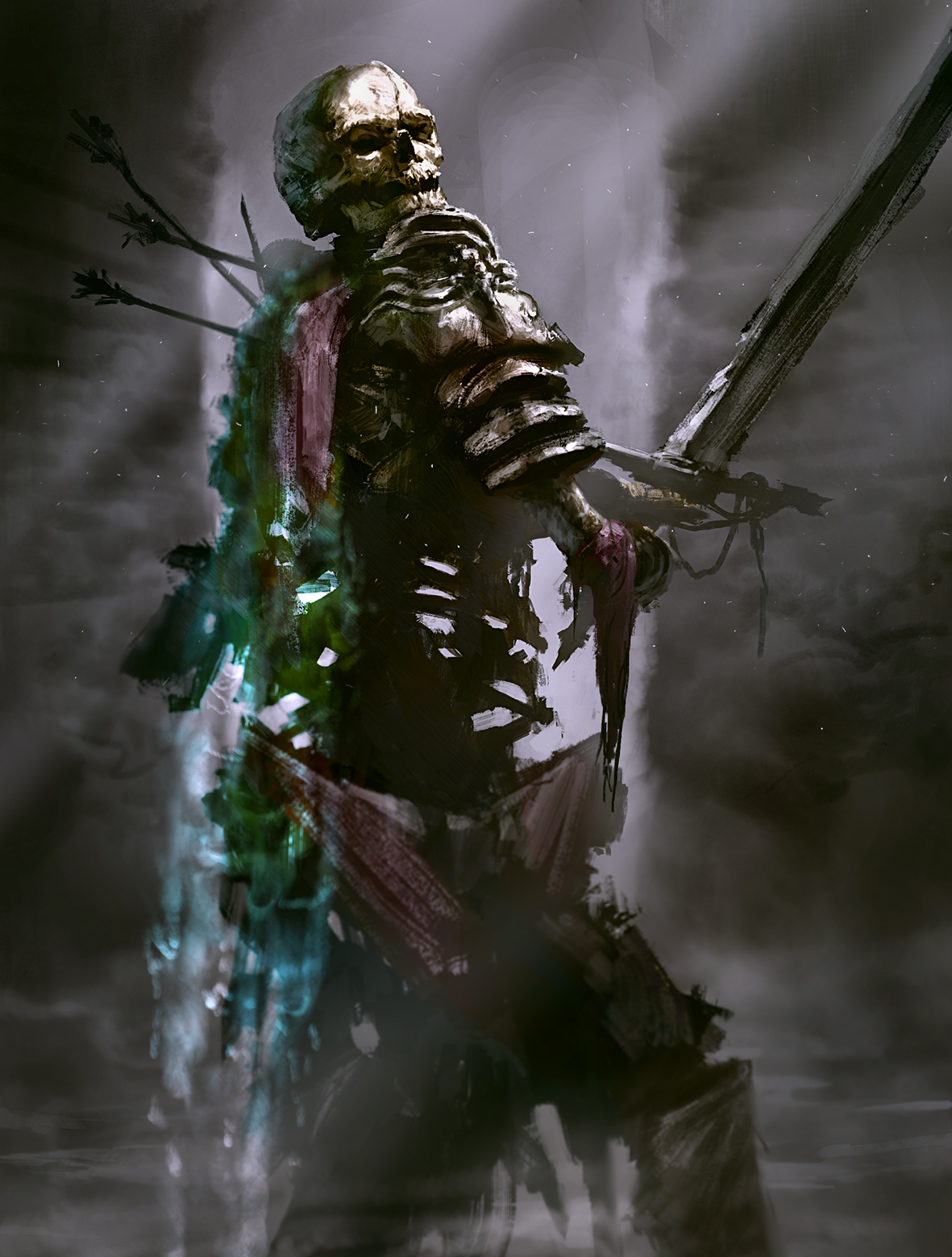see the previous post in this series
see the next post in this series
Initiative, Actions, Injury and Gear
I think I have teased enough about how to play the game that it is time to actually talk about how to take part in combat. Engaging in combat is deadly, and being flanked or caught off guard is a good way to cross to the other side of the Veil quickly. At the same time, not all weapons and armors are made equal. If you are lucky, or maybe cursed, you'll find something truly special.
Initiative
Adversaries take actions either on the King, 10, 5 or 2 for their initiative, depending on their adversary blocks. Fast adversaries typically take turns at higher values, slow enemies go later.
Players draw a number of cards equal to their Aspect score at the start of each round of combat. They may take an action on whatever values they draw. All suits are treated equally here, so four players drawing sixes results in 4 actions where the order is determined by the players deciding amongst themselves to then be executed simultaneously. After a turn put the corresponding card into your discard pile.
Jokers of either color are wildcards and can go at any turn in the round.
Each turn is three seconds long. A round is thirteen turns long.
You may at any point on your turn transfer other cards you have drawn and not already used that round to your Baize.
Actions
Combat has a lot going on, and turns are numerous. As such, there is usually a lot to do as well. Notably, combat takes place on either a square, hex, or grid-less map made up of one-inch increments. Facing is important in this game as noted in the description of "Flanking" below.
|
Action
|
Description
|
|
Move
|
A character may Move up to 5 yards per round on their turn without taking
an action. A character cannot Aim and Move on the same turn. Choose a facing after Moving. You may choose to Move 0 yards.
|
|
Brace
|
Gird yourself for an oncoming blow. Attacks from a Bracing
character’s front suffer a -1 card penalty until their next turn.
|
|
Sprint
|
Characters may Sprint as an action. You may not Sprint and Move in the same turn. The distance Sprinted in a
round cannot exceed 5 * Health yards (minimum 5). Choose a facing after Sprinting.
|
|
Aim
|
Take time to size up an opponent and land a decent blow.
Can be used for ranged and melee attacks. Characters that Aim receive a +1
bonus on their next Attack or until they Move. This is cumulative up to +3. Characters cannot Move and Aim
on the same turn.
|
|
Attack
|
Attacking Characters make an Aspect Check against a target within
their weapon’s reach. On success, deal one damage increment.
|
|
Make a Check
|
Characters may take an action to make Checks as normal
(look around for hidden things, break down a door, pick a lock, etc.)
|
|
Retrieve/Grab an Item
|
Characters may take an action to sheath or wield a weapon, grab
an easily reachable item, remove a backpack, pull a lever or similar.
|
|
Special Actions
|
Characters often have specific actions they can take
depending on their gear, Class, or enemy template.
|
|
Make Something Up
|
If you think of something not on this list, pitch it to your GM!
|
When a player inevitably pitches an idea not on the above list, see if it fits one of the categories already listed. If not, it a good guideline is to have them make an Attribute Check while keeping in mind that a +1 Card bonus or -1 Card penalty is slightly more impactful than +2 or -2, but not as impactful as +3 or -3. +2 Cards is in between +3 and +4. +3 Cards is in between +4 and +5. You should not give penalties that reduce card draw to zero, or bonus that result in drawing more than 5 cards.
Injury
Death comes easily in this game. Without armor, you are usually only a couple of good hits away from a painful death. By default, a character has the Healthy status, meaning there isn't anything immediately concerning about their physical well being. Getting hit with an attack moves a character from Healthy to Injured. Getting hit while Injured makes them Critical. Getting hit while Critical means the character has become Dead. Death is permanent, and returning from beyond the Veil is, as far as scholarly science and mysticism can tell, impossible in any meaningful way. Remember that retreat and escape are almost always options!
Recovery
Wounds typically can only be recovered while resting with adequate medical supplies on hand. This can be anything reasonable, but usually comes as medical supplies (1X). If you are recovering in a town, it is assumed you will be able to acquire adequate supplies. In the wilderness or elsewhere, a Health Check is necessary to recover if no medical supplies are available.
Flanking
A character is Flanked if they are Attacked from the direction of a square, hex or angle not in a 45 degree arc of their front. Flanking an opponent provides a +1 Card bonus and ignores the armor and Bracing benefits provided by shields. After being hit with a Flanking attack a character may choose to face the direction of their attacker.
Gear
As unique as a character may be in their Class, none of that matters if you don't have the gear to survive an expedition until you can get paid! In addition to whatever starting gear a Class receives, all player characters start with 2 Flakes, five days of rations, twenty feet of hempen rope, and a set of modest clothing.
Armor
Armor is vital to the long term survival of most folks that end up in a combat environment. It provides a couple of benefits in the mechanical sense and is worth getting ahold of should you be able to wear it. Firstly, armor reduces incoming damage by an amount equal to its value. Second, it applies a -X penalty to attackers trying to hit you, where X is the armor value. Only the smallest armor value of your equipment applies.
Armor Damage
If you get hit, you decrease the armor value (AV) of the armor by one. If AV reaches zero, it is useless until you get it to a craftsman of the appropriate type. If it is only damaged, each piece can be repaired at camp or similar. You may be thinking "But wait, doesn't armor cover multiple parts? How do I know what was hit?" Fair question! That's up to the creature being hit. Track each armor piece individually, but its effect holistically.
An Example
Alex has Leathers (HeALTF AV1) and they get hit. Alex marks their left leg's armor as AV0, meaning the armor is damaged. They takes another hit, and decides it was in their right leg. Then their left and right arms, then the torso, both boots and finally the helmet. Now, after eight hits, Alex is able to become Injured and their armor is fully destroyed! It is easy to see why you might want to grab yourself a buffer as useful as this on your journeys.
Now, GMs, be sensible. If Alex sticks their hand in a jar of acid with a gloved hand, it may spare their delicate fingers and damage the glove. It won't, however, let them get away with it a second time by marking down their boots as damaged.
Layering Armor
Armor can be layered, and damage to that body part has to break the highest value armor before damaging lower value armor in the same Slot. a Breastplate (2T, AV3) over a Chain Shirt (2T, AV2) provides hefty damage reduction to the Torso, but you cannot assign damage to the Chain Shirt before the Breastplate is destroyed.
Shields
Shields provide further benefit to the wielder's front side, acting as a passive increase to AV from that side as well as always being hit if a character decides to Brace. Additionally, while Bracing, your shiel'd AV counts for the armor penalty to hit you, not your lowest AV armor. Taking a shield off requires 1 minute of time, unless it is a buckler that may simply be dropped.
Weapon Ranges
One-handed melee weapons have a maximum reach of 1 yard. Two-handed melee weapons have a maximum reach of 2 yards. Ranged weapons specify their maximum effective range and cannot be used in combat past that value.
Gear Tags
This list is not comprehensive and is likely to grow in the future. However, it should be enough to provide inspiration for the sorts of things one could apply to weapons.
|
Tag
|
Description
|
|
Armor Breaking
|
Hitting an armored target with
this weapon instead deals damage twice to the same location.
|
|
Brutal
|
Hitting a living
target with this weapon instead deals damage twice.
|
|
Long
|
This weapon’s reach is 1 yard longer
than normal.
|
|
Firearm
X
|
This weapon takes
X turns to reload. Consider carrying spares. Reloading may be stopped during
any turn but cannot be resumed until you take another turn to do so from
where you left off.
|
|
Quickdraw
|
This weapon can be drawn or sheathed without taking an action.
|
|
Edible
|
This weapon counts as a ration worth as many meals as its size.
|
|
Gossamer
|
Spun from the fabric of the Veil, this weapon counts as a Pierce in the Veil for all purposes.
|
|
Audited
|
Hyper-real and stamped with "NORMAL" on the haft, this weapon is immune to magical effects.
|
|
Cooldown
|
This weapon can only be used once per scene.
|
|
Polarized X
|
-1 Card penalty to use unless you have the appropriate Aspect
|
|
Slow X
|
This weapon is either a siege weapon or shipborne cannon and takes X turns to set up and use each time.
|
|
Shoddy X
|
This weapon requires maintenance regularly or else breaks after X uses.
|
|
Delicate
|
This weapon will break after Attacking if used in harsh conditions (underwater, torrential rain, forest fire, cave-in).
|
|
Over/Under Sized
|
This weapon is not made for someone your size. -1 Card to Attack. Ratlings ignore Undersized.
|
|
Clumsy
|
This weapon can only be used against a target with 0 movement remaining in this round..
|
|
Heavy
|
This weapon must be Aimed before you can Attack. Aiming confers a +1 Card bonus instead of +1.
|
|
Defensive
|
You may Brace with this weapon. It counts as an AV 1 shield and does not break when hit by passing an Aspect Check.
|
|
Portable
|
This weapon is 1 size smaller than normal. It must be assembled or disassembled with an Action.
|
|
Crushing
|
This weapon counts as Brutal against inanimate objects.
|
|
Hooked
|
This weapon features a prominent hook, most often used to disable shields. If you succeed a contested Aspect check against the target, they lose the benefit of their shield until your next turn.
|
|
Rapid
|
This weapon is especially nimble and makes up to 2 attacks per turn.
|
|
Disarming
|
This weapon is designed to remove another's. Make a contested Aspect Check, If you succeed, their weapon is tossed 1-3 yards away in a random direction.
|
|
Dazing
|
On hit, the target makes a Sense Check vs losing their highest remaining Card this Round.
|
|
Menacing
|
This weapon menaces with spikes, iconography or other such thing. On hit, make a Red Check. If you succeed, the target becomes Scared of you.
|
|
Gentle
|
This weapon is blunted. You may choose to be nonlethal with this weapon. If you do, it is Brutal as well.
|
|
Poisoned | This weapon is poisoned. On hit, the target saves vs the relevant poison.
|
|
Diseased
|
This weapon is diseased. On hit, the target saves vs the relevant disease.
|
What Comes Next
Now that the basics of combat rules are laid out, it might be useful to have something and someone to fight against. Next up: Adversaries and templates to spice them up After that will be Camping and Downtime. I want to go ahead and thank the folks that provide me feedback on these posts after I post them; you are greatly appreciated. One of these days when I have all the posts I can think of written I will compile them into a .pdf in a more organized matter.









